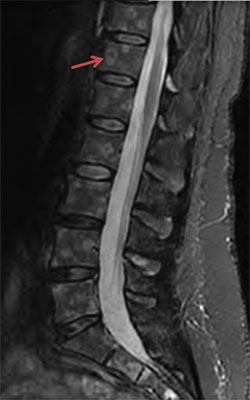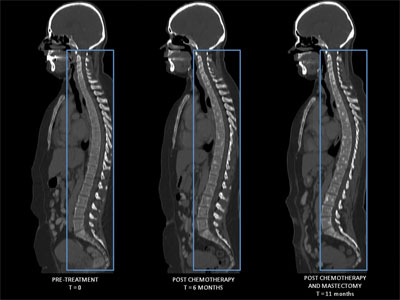Assessment of treatment response in lobular breast carcinoma metastatic to skeleton
A 55-year-old woman with history of hypertension presented to her gynecologist with a chief complaint of nipple retraction.
A mammogram revealed an irregular mass in the upper outer quadrant of the left breast. A sonogram revealed a 5.3-cm mass with irregular margins, 4 cm from the nipple, and a 2.9-cm lymph node in the left axilla. Ultrasound-guided biopsy of the mass and lymph node revealed a moderately differentiated invasive lobular carcinoma that was strongly ER-positive and PR-positive, but negative for HER-2 (0 by immunohistochemistry). The histology of the left axillary lymph node was consistent with metastatic lobular carcinoma.
A PET/CT scan revealed low-grade metabolic activity of the known breast mass, with maximum standardized uptake value (SUV) of 1.8, and numerous rounded homogenous lymph nodes in the upper and mid-left axilla, measuring up to 1.1 cm. Many had lost their fatty hila.
In the liver, there were three hypodense lesions measuring up to 1.5 cm, with no hypermetabolic activity.
In the bilateral proximal femora and in the left lower pelvis, there were several scattered small sclerotic foci, thought to represent either osteopoikilosis or enostosis. There was no hypermetabolic bone lesion to suggest osseous metastasis, although these were quite small and seen in the presence of diffuse mild metabolic activity of the marrow.

Figure 1. A left-sided breast mass with localizer clip (red arrow) demonstrates faint low-grade metabolic activity on the corresponding FDG-PET images (blue arrow).
Source: M. Ghesani, MD
MRI of the liver was performed to further assess hypodense lesions seen on CT. The MRI findings were consistent with hepatic hemangiomas, but there were several lesions in the spine that were suspicious for metastatic disease. Bone scan did not reveal any suspicious findings in the femurs, pelvis or lumbar spine. X-ray of the lumbar spine and pelvis did not reveal any gross sclerotic lesions, making osteopoikilosis less likely.
Because the lesions were not visible by CT, biopsy would have been difficult. In light of the diffuse metabolic uptake of her marrow on PET scan, bone marrow biopsy was done instead. It showed metastatic carcinoma, with histologic and immunohistochemical features of invasive lobular carcinoma.
Palliative hormonal therapy with tamoxifen, goserelin acetate (Zoladex, AstraZeneca) and denosumab (Prolia, Xgeva; Amgen) were initiated. After 6 months of treatment, tumor markers significantly decreased (CA27-29 decreased from 293 U/mL to 54 U/mL, and CA15-3 decreased from 204 U/mL to 31 U/mL) with absence of bone pain.
Interval PET scan showed sclerotic lesions throughout the axial and appendicular skeleton had increased in size and number, reflective of treatment response, and conversion of previously isodense metastatic lesions to sclerotic foci.
She underwent left breast mastectomy with immediate deep inferior epigastric perforator flap reconstruction and right reduction mammoplasty. Pathology revealed a 1.4-cm invasive lobular carcinoma of the left breast. Lymph vascular invasion was present. All margins were negative. Again, ERs were positive in more than 75% of cells, PRs were positive in 1% of cells, and HER-2 was negative (1+ by immunohistochemistry).
There were 12 lymph nodes removed, 11 axillary and one internal mammary. All contained metastatic carcinoma, the largest focus of which measured 2.5 cm with extracapsular extension.

Figure 2. Dedicated MRI of the lumbar spine demonstrates numerous osseous metastatic lesions (red arrow). The metastatic disease was first noted incidentally on an MRI of the abdomen 15 days earlier.
Surprisingly, in the right breast tissue that was excised as part of the reduction mammoplasty, there were at least two foci of invasive lobular carcinoma, the largest focus of which measured 3 mm. The lesions in the right breast were evaluated. Both were found to be strongly positive for ERs and PRs, but negative for HER-2.
Discussion
Bone metastases are diagnosed in 30% to 85% of patients with advanced breast cancer. This causes significant morbidity, such as pathologic fractures, pain, spinal cord compression and hypercalcemia, so early detection is of utmost importance.
The follow-up of diagnosed bone metastases during systemic therapy is also a clinical dilemma, especially if bone is the only site of spread. This is primarily because radiologically detectable lesions often persist even after successful systemic treatment. Serial plain radiographs, CT scans and MRI can assess bone lesions. Bone scans sometimes can be misleading, as the technetium phosphate accumulates in areas of osteoblastic activity rather than in cancer cells. This also may cause a scintigraphic healing flare, which may be seen as early as 2 months and may persist as long as 12 months after initiating therapy in patients with good response.

Figure 3. FDG-PET images (right) demonstrate diffuse increased marrow activity within the ribs (top/red arrow), scapula (top/blue arrow) and pelvis (bottom/red arrows).
Clinicians are faced with the challenge of differentiating new sclerotic lesions caused by progression from those that represent healing of pre-existing isodense or lytic lesions that were not detected on pretreatment radiographic imaging. This often happens because more than 50% of the trabecular bone has to be destroyed before the lytic lesion can be detected on conventional radiography.
Integrated PET/CT scan is used for staging and monitoring response to therapy in metastatic breast cancer, as it demonstrates high sensitivity and specificity. It provides both morphologic and functional assessments to help monitor treatment outcomes.
Tateishi and colleagues performed a retrospective study — published in 2008 in Radiology — that compared the morphologic and metabolic changes in bone metastases in response to systemic therapy (chemotherapy and hormonal therapy) in patients with metastatic breast cancer. After treatment, there was a decrease in the SUV and total lesion glycolysis and an increase in the mean attenuation of the lesion.
Univariate analysis revealed the increase in attenuation and the decrease in SUV were potential predictors of response duration. Multivariate analysis revealed a decrease in SUV was found to be an independent predictor of response duration. An SUV decrease of 8.5% or more after treatment had a 2.4-fold higher RR of long response duration during follow-up.
Unfortunately, due to lower glucose avidity of lobular breast carcinoma, metabolic response assessment with fluorodeoxyglucose PET (FDG-PET) has limited value. FDG-PET generally performs better in the setting of invasive ductal carcinoma.
Bone metastases
Bone metastases can be of three complex types — osteolytic, osteosclerotic and mixed. The sclerosis of a lytic component on CT or plain radiograph generally is considered to suggest response to treatment.
In a retrospective study by Katayama and colleagues published earlier this year in Annals of Nuclear Medicine, PET/CT was used to monitor bone metastases of breast cancer during therapy. There was a substantial correlation between PET findings and tumor marker levels, which may imply that PET is a reliable method for monitoring bone metastases during therapy.

Figure 4. Whole-body CT images were obtained during PET/CT studies at baseline (T=0), post-chemotherapy for restaging (T=6 months), and post-additional chemotherapy and mastectomy for restaging (T=11 months). Note that sclerotic lesions are not seen at baseline, but they progressively increase in size, number and density on post-treatment exams. Lesions seen on post-treatment exams did not demonstrate hypermetabolism on the FDG-PET images.
The researchers found that increases in SUV occurred most with lytic changes on CT images (95.4%), which was statistically significant (P<.05), and that these suggest progression of bone metastases. The PET findings tended to improve or remain negative in most of the cases of sclerotic changes on CT findings, which suggest an improvement or an inactive lesion. When mixed lytic and sclerotic changes were on CT imaging, an increase in FDG uptake was seen in most cases (18/22, 81.8%), although due to the statistical issue of multiple comparisons, a statistical analyses was not performed.
A notable number of lesions (35/432, 8.1%) exhibited an increase in FDG uptake at the same time at which sclerotic changes were observed on the CT findings. The researchers considered these lesions to be a different type of osteoblastic metastasis from those lesions in which sclerotic changes occur with improvement. Furthermore, they classified bone metastases into lysis-progression/sclerosis-improvement pattern (lysis during progression and sclerosis during improvement), or a sclerosis-progression pattern (sclerosis during progression) based on the changes observed during sequential PET/CT studies. Also, several lesions detected primarily by PET were not seen on CT. These lesions were thought to be intertrabecular metastases, which may also be missed on conventional radiography and bone scan.
The radiographic increase in size of existent lesions or appearance of new lesions must be correlated with the overall picture of the disease before designating progression of disease. This should be correlated with clinical history, tumor markers, SUV uptake, and lytic or sclerotic lesions before assuming treatment failure. In the appropriate clinical setting, MRI may be a helpful modality to assess treatment response or progression of disease.
References:
- Ciray I. Acta Radiol. 2000;41:178-182.
- Katayama T. Ann Nucl Med. 2012;doi:10.1007/s12149-012-0595-2.
- Tateishi U. Radiology. 2008;247:189-196.
For more information:
- Munir Ghesani, MD, is an attending radiologist at St. Luke’s-Roosevelt Hospital Center and Beth Israel Medical Center, an associate clinical professor of radiology at Columbia University College of Physicians and Surgeons, and a HemOnc Today section editor. Irene Dy, MD, is a fellow in hematology and oncology at St. Luke’s-Roosevelt Hospital Center. Seth Cohen, MD, is an attending oncologist at St. Luke’s-Roosevelt Hospital Center. Sharon Rosenbaum-Smith, MD, is an attending surgeon at St. Luke’s-Roosevelt Hospital Center. Francisco DeLara, MD, and Karen Kodsi, MD, are attending radiologists at St. Luke’s-Roosevelt Hospital Center. Christopher Moran, MD, is a radiology resident at St. Luke’s-Roosevelt Hospital Center.
